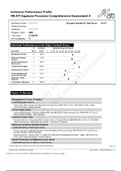Samenvatting
Samenvatting Management Accounting & Control MAC 2
- Instelling
- Hanzehogeschool Groningen (Hanze)
Dit is een Engelse samenvatting voor het tentamen van het vak: MAC 2. Dit vak wordt gegeven in jaar 2 van de opleiding Finance & Control (bedrijfseconomie). De samenvatting is in het engels want het tentamen is ook in het engels, Het boek The Fundamentals of Cost accounting is hier samengevat en oo...
[Meer zien]









